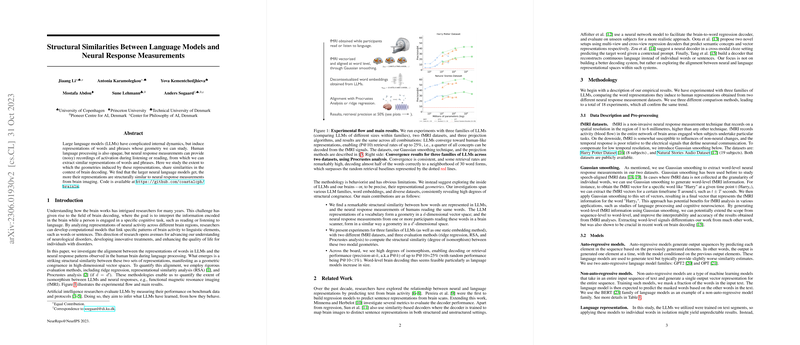The paper "Structural Similarities Between LLMs and Neural Response Measurements" explores the fascinating intersection between artificial intelligence, specifically LLMs, and human neural processing during language tasks. The primary aim of the paper is to investigate how the geometric representations of words and phrases in LLMs compare to those derived from neural response measurements obtained through brain imaging techniques.
The authors delve into the following key areas:
Representation Geometry
- LLMs: These models create intricate internal representations of language data. The geometry of these representations, which can be analyzed through various mathematical and visualization techniques, reflects the way LLMs encode semantic and syntactic information.
- Neural Responses: Using brain imaging technologies like fMRI or EEG, researchers can measure neural activations when subjects engage in language tasks, such as listening or reading. Although these neural measurements are inherently noisy, they can still be used to extract meaningful representations of language in the brain.
Comparative Analysis
The core of the paper is the comparison between the geometric structures of representations from LLMs and those from human brain activity:
- Structural Similarities: The authors find that as LLMs grow in size and complexity, the structural similarity between the induced representations and those derived from neural data increases. This suggests that more advanced LLMs might be capturing language representations in a manner akin to the human brain.
- Brain Decoding: Using brain decoding techniques, the researchers demonstrate that the representations from larger LLMs can effectively predict neural response patterns. This implies not only a superficial resemblance but a deeper alignment in how both systems process and encode linguistic information.
Implications and Contributions
- Understanding Human Language Processing: The findings offer insights into the possible mechanisms of human language processing, suggesting that artificial models might serve as useful analogues for studying the brain.
- Advancements in AI: By showing that LLMs' representations become more brain-like as they grow, the paper advocates for the development of even larger and more complex models to better understand and simulate human cognition.
- Brain-Computer Interfaces: These results could serve as a foundational step towards enhancing brain-computer interfacing technologies, using LLMs to interpret and predict brain states related to language.
Methodology
- Data Collection: The paper employs extensive datasets of neural response measurements during language tasks.
- Model Training: Various LLMs of different scales are used to generate language representations.
- Analysis: Comparative metrics and visualization techniques are applied to assess the similarity in geometries between LLM and neural representations.
Conclusion
The paper provides compelling evidence that the internal representations of larger LLMs increasingly mirror the patterns observed in human neural responses during language processing. This structural similarity opens new avenues for both AI research and the understanding of human cognition, suggesting a convergence of computational and biological systems in handling language.
The code for the experiments conducted in this paper is made publicly available, promoting transparency and facilitating further research in this burgeoning field. This work stands as a significant contribution to both computational neuroscience and the development of more advanced LLMs.
